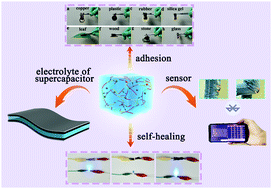Mechanical, adhesive and self-healing ionic liquid hydrogels for electrolytes and flexible strain sensors†
Abstract
With the prosperity of flexible energy storage and wearable strain sensing, the ion conductive hydrogel attracts booming attention as electrolyte materials of flexible supercapacitors and flexible strain sensors due to the distinguishing soft and wet feature. Herein, a self-healing hydrogel with mechanical, adhesive and conductive properties has been designed and prepared by introducing polydopamine nanoparticles and water-soluble ionic liquids into hydrophobic association polyacrylamide. The resultant hydrogel samples could be employed as an electrolyte and wearable strain sensor, simultaneously. As hydrogel electrolytes, the resultant supercapacitor possesses a capacitance of 0.37 F g−1 and capacitance retention of 75.42% after 8000 cyclic charge–discharge tests. Furthermore, the supercapacitor exhibits a capacitance of 0.365 F g−1 after self-healing, which is 98.65% compared to the original data. As flexible strain sensors, the hydrogels could detect tiny and large-scale human movements in accordance with resistive signals and a gauge factor of 0.841. It could be anticipated that the self-healing hydrogels could be prospective flexible materials for a new generation of flexible sensors and supercapacitors over a wide temperature range.



 Please wait while we load your content...
Please wait while we load your content...